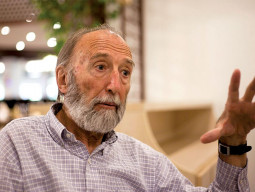
While foreign groups have returned home after 10 foreign trekkers and their Pakistani guide were gunned down at the foot of Nanga Parbat last month, Baltistan remains as peaceful as before. And with as much to offer – especially to those looking for solace in the shadow of mountains.
Ain’t no mountain high enough
The Baltistan region contains four peaks which stand above 8,000 metres – K-2 (8,611m), Gasherbrum-I (8,068m), Broad Peak (8,048m), and Gasherbrum-II (8,035m). Many others stand at above 7,000 metres, such as Masherbrum and Gasherbrum-IV.
A trainer by profession, Rajput runs an academy where he instructs people in mountain climbing. Since 2006, 500 people have passed through Khurpa Care, his school based in Skardu.
“Those who enrol are mostly climbers, guides and porters,” explains Rajput, who was tutored by “acclaimed Italian and US trainers.”
He plans on holding yet another training session in the coming week for those seeking to become porters and trekkers to earn a living.
Khurpa Care also imparts free ‘basic training courses’ for those taking their first steps and fumbles climbing or trekking. “But the group should have no fewer than 10 people.”
Knowing those ropes
The syllabus includes courses in first aid, self rescue, awareness about pollution, climbing, health and sanitation and camping techniques, among others.
“A professional course is completed over four years – each year requires at least eight to 10 days hands-on training in the field,” shares the teacher, who recently went for a refresher course in Nepal. “The cost of a (Khurpa) course is approximately Rs150,000 per year.”
Known for being a comparatively easier slope to scale, trainers often choose the 5,700-metre tall Gondogoro La Pass for newbie trekkers.
In some cases, base camps at an approximate height of 6,000 metres can also be the destination for learners. “It normally takes them about 10 to 12 days to reach the elevation and return to ground level,” said Rajput.
Explaining the difference between trekking and climbing, Rajput says the journey up to the base camp is called trekking while the bit beyond requires actual climbing.
Most trainers cannot place enough emphasis on the use of rope in mountain climbing. “It allows you to remain connected with the rest of your team members in an expedition,” points out Rajput. At least 60 metres of rope is required to connect a group of three climbers.
Easy on the pocket
The ‘game of the affluent’ as it is colloquially known does not require as much investment in G-B as it would in a developed country.
In G-B, members of expedition groups often resell parts of their equipment such as shoes, ropes, and clothing at comparatively affordable rates to retailers, who then sell the products in stores. A pair of used shoes cost around Rs5,000, while a jacket and a pair of trousers would be priced at Rs3,000. About 60 metres of rope would sell for Rs10,000.
“These are almost half the original prices,” notes Rajput.
The town where Rajput lives – Skardu – is accessible by road as well as by air from Islamabad. There is a flight to Skardu airport almost daily; the journey takes an hour. For Pakistani passengers, a return flight costs Rs16,000 from the federal capital.
If you prefer to journey by bus, it costs Rs3,000 for a 22 to 25-hour long journey. Landslides on the Karakoram Highway are not uncommon, but bulldozers usually clear the road relatively quickly.
Risky ascents up treacherous slopes have trained Rajput to turn a challenge into an opportunity. However, he has less power to turn poor circumstances such as terrorism upside down to his advantage; only the government has that kind of sway, the trainer points out.
“We guarantee the safety of every tourist in Skardu and elsewhere in G-B,” Mehdi Shah said while expressing regret over the Nanga Parbat massacre.
Fun facts about G-B
Eighteen of the 50 world’s highest peaks are located in Gilgit-Baltistan. These heights include
• K2, 2nd-highest peak in the world at 8,611m.
• Nanga Parbat, 9th-highest in the world at 8,125m
• Gasherbrum-I, 11th-highest in the world at 8,080m
• Broad Peak, 12th-highest in the world at 8,047m
• Gasherbrum-II, 13th-highest in the world at 8,035m
• Gasherbrum-III, 15th-highest in the world at 7,946m
• Gasherbrum-VI, 17th-highest in the world at 7,932m
• Distaghil Sar, 19th-highest in the world at 7,884m
Outside the poles, three of the world’s seven longest glaciers are located in G-B – the Biafo Glacier, Baltoro Glacier, and Batura Glacier.
The most outstanding of these three rivers of ice is the 62-kilometre (km)-long Baltoro. This large glacier, fed by some 30 tributaries, has a surface area of 1,291.39 square km.
Published in The Express Tribune, July 16th, 2013.
































1714024018-0/ModiLara-(1)1714024018-0-270x192.webp)










COMMENTS
Comments are moderated and generally will be posted if they are on-topic and not abusive.
For more information, please see our Comments FAQ